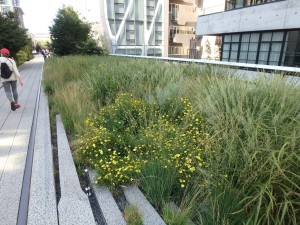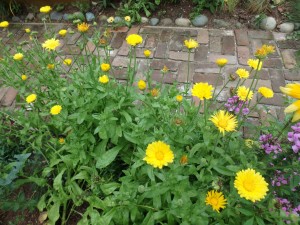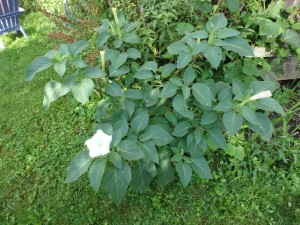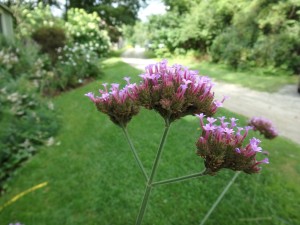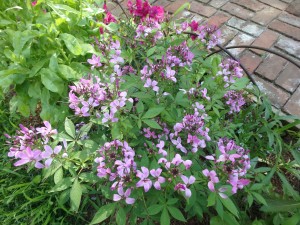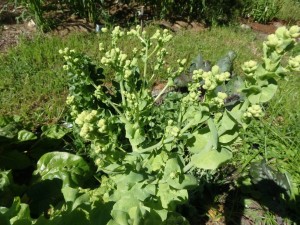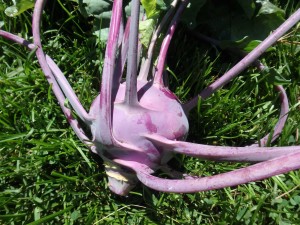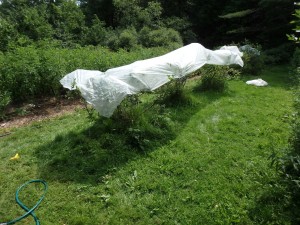Are Blueberries For the Birds? Or For Us?
I gave a lecture and slide show recently about good plants that support our feathered friends. I talked about good habitat for nesting and safe places to rest while avoiding cats. But when I showed plants birds like to eat, some gardeners were surprised when I showed blueberries: they didn’t want to share. Many of those same people buy black oil sunflower seeds in 50 pound bags every month all winter. But share the blueberries? No way. If you don’t want to share, let’s look at the options.
Years ago when I was in the category of “blueberries are for me, not the birds” I developed an easy netting system that kept the birds off – but I no longer use it. Netting allows the birds to see those ripe berries, taunting them if you will, and some will get caught in the netting trying to get in. A friend recently reported finding 3 dead and rotting birds in the blueberry netting of a friend who was away. I haven’t used nets in years.
But let’s assume you want to net and are willing to check the nets frequently for caught birds. I suggest using tall plastic hoops that will allow you to drape wide swaths of netting over the bushes and easily slide it off to pick.
Buy 10 foot lengths of PVC pipe that is ¾ inches in diameter. For smaller bushes, cut some pipes in half and glue them to full length pieces to produce 15 foot long pipes. For large mature bushes, use 2 full lengths. Every 10 feet of a row of blueberries needs a hoop. Just bend the pipe to make a hoop, and push into the soil. I kept the netting in place with hair clips, the kind with 2 rows of teeth and a spring. On the ground I used landscape staples to hold the netting down and keep birds out.
I called my buddy Chris Dye of Noda’s Blueberry Farm in Meriden, NH (www.nodafarm.com). He said they bought a noise maker to keep the birds at bay. It’s called a Bird Gard Pro. (http://www.birdcontrolpro.com
Then I called Riverview Farm in Plainfield, NH and talked to Nancy Franklin. She and her husband have a huge fruit operation – apples, blueberries, raspberries, pumpkins and more (http://www.riverviewnh.com/). Nancy said that their berries are mostly late-season varieties, especially one called ‘Elliot’. By the time they are ripe, many of the bird culprits are getting ready to migrate and have changed their feeding habits, and are less of a problem. So they share a few, but don’t lose too many.
One problem with late-season berries whether blueberries, raspberries or strawberries is a new pest that arrived a few years ago: the spotted winged drosophila, a foreign fruit fly. Unlike our native fruit flies, this one attacks good fruit, not rotten fruit. So I don’t recommend any late season varieties until someone develops a predator insect that will control this new pest.
Birds evolved to avoid large predatory birds like owls and hawks. So you can buy a plastic owl and put him out in your blueberry patch, but birds aren’t stupid. Unless you are going to move it from tree to tree, they’ll figure out it’s not real.
Birds don’t like shiny things, either. I’ve known gardeners to hang old music CD’s they no longer enjoy in the bushes. The wind blows them, and they shine light at the birds. But then again, in time, they might start rocking to “Grandma Got run Over by a Reindeer” instead of flying away.
I also have some Nite Guard Repellent tape. This is shiny tape designed to scare birds with movement, noise and light (http://www.niteguard.com/). At $15 for a 100 foot roll, it is affordable – and probably helps.
I have a bumper crop of blueberries ripening up now on my 7 bushes. I attribute that to the fact that I have been spreading agricultural sulfur around the bushes for a few years, getting the soil very acidic. Soil pH is very important, and you can add sulfur any time. But don’t add acidic fertilizer now (Holly-Tone, for example) as that should be done in early June. Fertilizer now would stimulate new growth which could easily be damaged in winter.
So this year I decided to put Reemay or “row cover” over my bushes. It’s a light-weight agricultural fabric designed to keep bugs off crops. I keep it in place with ordinary wooden clothes pins. It only cover the top of the bushes, or a little of the sides, but birds flying over won’t see it. And if my resident robins want to go on the ground and pick up berries, why not? There is nothing to harm the birds, and it is an inexpensive, quick–to-install solution. So put me in the category of “willing to share – a little – with the birds.”
See Henry’s twice-a-week blog at www.dailyuv.com/gardeningguy. He is the author of 4 gardening books, and a lifetime UNH MasterGardener.
On Becoming a Good Gardener
At a neighborhood cookout I met a woman who asserted that she had a “brown thumb.” Although this is not the first time I’ve heard someone say they couldn’t grow anything, I always take issue with such statements. No one is born with an ability to garden; some of us become good gardeners over time as we learn, and as we improve our soil. Good gardeners learn from their mistakes – I’ve killed plenty of plants, but I try not to let that discourage me. Good gardeners observe our gardens carefully, visit other gardens, and read the words of other gardeners.
Ms. Brown Thumb was surprised to learn that I went to my garden every day, generally several times a day. She just visits hers on the weekends. Good gardeners pull a few weeds every day, pick bugs, and marvel at the wonders of their flowers.
She was also bothered by bugs. She didn’t want to be bitten by them, or, I gather, touch them; I imagine handling slugs or snails would be unthinkable for her – though routine for me. Many of my gardening friends think nothing of squishing snails or Japanese beetles between their fingers, though others prefer dropping them in soapy water. Still, bugs are a part of gardening.
Observation is important. If you don’t see what is eating your squash or potato leaves, turn over the leaf. Chances are you’ll find the culprit – or a clue like their eggs. Go out at dawn, or just before bed with a flashlight to see what the problem is. Good gardeners are amateur sleuths, too.
My grandfather, John Lenat (1885-1967) was a great gardener. He always had a compost pile full of earthworms made from weeds, kitchen scraps, and chicken or cow manure. He treated his soil and plants to liberal doses of compost when he planted, and often gave his tomatoes manure tea that he made in an old wooden barrel. We mixed hen manure and water (roughly 4 parts water to one part manure), stirred it daily, and fed his tomatoes one 12oz can of tea at least once a week.
Good gardeners love being outdoors, and don’t mind getting dirty. Remember the character Pig Pen in Charles Schultz’s comic strip, Peanuts? Gardeners are a bit like that. I am forever wiping my hands on my pants so that I can clean my glasses or dig a knife out of my pocket.
I have a network of gardening friends, and we are forever exchanging ideas and plants. Sometimes we even get together to help a friend catch up on weeding – a grand idea if you get behind – or just to have a potluck and talk gardens. I recommend it.
Garden clubs are another great way to learn about gardening. Although the summer is about over, many clubs have garden tours each summer. I love to visit gardens that are not open to the public. There is nothing like seeing how another gardener designs a garden, or the conditions that a particular plant likes.
Public gardens are wonderful resources, too. I just visited the High Line, a garden in New York City that was built on an abandoned elevated railway line. It’s over a mile and a half long and has a fabulous collection of not only of perennials and grasses, but trees and shrubs, too. I brought my camera and a notebook to record the walk, and to help me remember names of plants I want to research.
Books can be a great help when it comes to gardening, too. Even experienced gardeners can be reminded of facts we forget. How many years are bean seeds good for? How about onions? I find myself going back to Ed Smith’s book, “The VegetableGardener’s Bible” (Storey Publishing) to jog my memory. And Barbara Damrosch’s “The Garden Primer” (Workman Publishing) is a great resource on many topics; I assigned it to my students when teaching college-level sustainable gardening. I’ve even been known to refer back to books I’ve written on occasion! We can’t remember everything.
I know that the internet is a great resource, too. As an older gardener I tend to reach for books on my shelf when I have a question, but I’m increasingly using Wikipedia or university sites for information. And I’ve been able to identify wild plants by using Google – I just list three characteristics of a plant, and it presents me with a number of options – including the right one.
The key to having a green thumb, I think, is to get to know soils –and how to improve them. Good compost is full of organic matter and living beneficial organisms. I add it liberally to my soil and have for years. Now plants beg to come home with me so they can thrive and have babies. Of course, the weeds do, too!
Read Henry’s blog posts at https://dailyuv.com/gardeningg
Mid-summer Tasks in the Garden
By now my gardens are well established and most plants are doing well. But there are tasks, both in the vegetable garden and in the flower beds, that need my attention.
Weeding is key in both areas, and recent rains make doing so easier as the soil has softened up. If you have very dry soil where you are, you might want to water well before weeding.
Why worry about weeds? I know gardeners who don’t do much weeding in their vegetable gardens. One even told me that if he weeded too much the deer would find his vegetables! But weeds anywhere in the garden are going to spread seeds soon – whether in the walkways or up close to your tomatoes. And seeds will come back to make more work now – and in the years to come. Many weed seeds act like time release capsules, some germinating now, some later, some 5 years down the road.
Weeds compete with your plants for moisture, soil nutrients – and even sunshine as they get bigger. I use a CobraHead hand weeder (www.CobraHead.com). It’s shaped a bit like a curved finger with a sharp pointy spade-shaped tip about an inch across. It easily gets under weeds so that I can pull from above (with one hand) and from below (with the CobraHead) at the same time, or tease long roots out of the soil without breaking them.
Thinning your carrots, beets and other root crops is an urgent job if you haven’t done so yet. Like weeds, vegetables growing too close to one another will compete for sun, water and nutrients. Carrots and beets should be at least an inch apart by now. And in a month, you need to thin them to 2 inches apart. Pulling the sharp tip of a CobraHead alongside a row of carrots will loosen the soil, sever a few side-growing roots, encouraging those that go deep. And scratch in some organic fertilizer now, too. It will help you get bigger carrots.
By the way, you can transplant carrots as you thin them out. Poke a hole deep enough so that the carrot will not bend, drop it in, press down the soil, water. It’s not a 100% reliable technique, but I hate to kill plants and have found it works most of the time. Do it in the evening, so they will have all night to recover before the hot sun hits them.
My onion patch was recently weeded, but I know that weeds will be along soon. So I mulched my onions with grass clippings. I find they work better than straw or hay in tight quarters like the onions. And green clippings may add a little nitrogen to the soil as they break down.
In many gardens the lower leaves of tomatoes are starting to yellow and develop dark blotches, sure signs of early blight. Although this blight is not immediately fatal, it reduces crop yield. By the end of August stems are often bare of leaves. You can minimize it by pruning off the affected leaves and all lower branches that touch the soil or are near it. Work on your plants when they are fully dry as the disease spreads more easily when leaves are wet.
I use scissors to remove the leaves, dipping them frequently in a glass of rubbing alcohol to sterilize them between plants. I wash my hands in a bucket of soapy water between plants. To see an in-depth article about this procedure along with many pictures, go to https://dailyuv.com/news/
I always plant my potatoes in June, even though manygardeners start planting them in April. I do this as I ‘ve found that I have fewer potato beetles by planting late. Maybe they’re all at my neighbors’ gardens. But do take some time to check yours to see if any beetles are eating the leaves. Look for larvae, and for orange egg masses on the underside of leaves.
When you plant your potatoes the roots will grow down below the seed potatoes and the new potatoes will form above them. Now is a good time to add soil over the developing potatoes. This is known as hilling them. I plant mine using a post hole digger, so it’s easy to fill in above my seed potatoes, just pushing the soil from mounds next to each plant. You can also use a hoe and scrape soil from the walkways. Don’t worry if some leaves get buried. They won’t complain.
In my flower gardens I am mainly weeding and cutting back flowers stems that have already blossomed. Weeding gives me space to plant new flowers – even though I have an extensive palette of plants, I constantly go to garden centers to see new things, or plants I once had that have disappeared. (Yes, I kill a lot of plants, we all do).
Cutting off spent flowers is good. Important. It takes a lot of energy to produce seeds. By pruning back the spent flowers, your plants have more energy to develop good roots and strong stems.
So get outside and enjoy summer and pull some weeds. Yougarden will look better and you’ll feel better, too.
Henry is a UNH Master Gardener and the author of 4 gardeningbooks. His website is www.Gardening-Guy.com. Read his twice-weekly blog at https://dailyuv.com/
Free Flowers!
Right now my front walkway is dominated by annual flowers, many of them that I did not plant – not this year, anyhow. First and foremost are the calendula. These are wonderful bright yellow flowers in the composite family, like daisies or sunflowers. They blossom and then drop seeds on the soil so they come back every year.
To have a nice supply of calendula, all I had to do was leave some of the seedlings to develop this spring. The seedlings are easy to identify: their color is a bright green the color of young lettuce. I removed many, but left a dozen or so. Right now they are gorgeous.
Another of my annual favorites that seeds itself is a big, bodacious flower with white blossoms that are often more than 6 inches long and shaped like a trumpet: Angel’s trumpet or Datura. It comes in both white and purple forms, though I have not been impressed with the purple ones – they are much less vigorous, with fewer blossoms.
Angel’s trumpet is my substitute for Asiatic and Oriental lilies which I can no longer grow- they are consumed and ruined by an invasive red beetle. Unlike the true lilies, Angel’s trumpet is not bothered by the beetles and blooms all summer. I have read that the seeds and flowers are poisonous – they produce severe hallucinations. But the seeds come in spiny covering, so few kids or animals are likely to want to put them in their mouths.
When I see their distinctive leaves in the spring I move them to a place where I have space for a plant that is often 4 or 5 feet across and 2 to 3 feet tall. Some years I get plenty of “babies”, other years I do not. They grow best in full sun to part shade in rich soil that stays a little moist.
Also on my front walkway is a tall plant with tough, thin, wiry stalks that often reach 4 to 5 feet, Brazilian verbena (Verbena bonariensis). In our climate this is an annual, but back home in South America it is a perennial. It has reddish-blue flowers, usually in groups of 3 at the tops of the stems. It rarely needs to be staked.
Its spring leaves, important to recognize if you want free flowers, are in pairs with serrated edges and roughly the shape of an elongated tennis racket. Look hard at the leaves now, noting the color and texture – even though the mature leaves are greatly elongated.
Of course, if you want to get flowers to self-sow, you must allow seeds to fall on bare soil. Even a 1 or 2 inch layer of mulch will prevent most seeds from finding a home and growing. If you are well mulched, you will need to monitor the seeds so you can pull back the mulch and sprinkle some on the ground when they are brown and ripe.
But there are other ways to get lots of plants besides encouraging self-sowing. Some perennials spread by root, turning a small clump into a big one in now time at all. Bee balm (Monarda didyma) is one that is a well-known spreader. Of course it is a lovely flower and most of us are happy to have more. And it pulls up easily, so I don’t call it a thug. Mine do best in part sun – morning only – and soil that doesn’t dry out too much.
In a funny quirk of fate, one of the least obedient plants I grow is called obedient plant (Physostegia virginiana). This is a beautiful tall pink plant that grows and spreads like crazy! It is a great cut flower with square stems with little florets up and down it.
Here is what I recommend: If you want to grow obedient plant, put it in shade, and don’t give it too much moisture. I have it growing under a rosemary willow that has its lower branches pruned off, and it is lovely there. And if it grows towards the sun, it’s in the lawn where my mower will keep it line.
Obedient plant also comes in a form with green and white leaves. This spreads a little, but it is not a thug for me. Whenever you have white portions of leaves, the plant gets less food because there is no photosynthesis in the white parts. That will make them less able to survive our winters, too. Plantswoman Nina Klinck at E.C. Brown Nursery in Thetford, VT says, “A variegated leaf plant is one zone less hardy than the same plant with all green leaves.” I agree.
One last suggestion: Don’t fertilize thugs or any plants that might take off and run. The less nitrogen and other nutrients in the soil, the more likely it is that you can control overly vigorous plants. Even adding compost to the planting hole is giving it an advantage it does not need. Put a thug in dry, crummy soil and maybe, just maybe it will behave itself.
Read Henry’s blog twice weekly at https://dailyuv.com/




